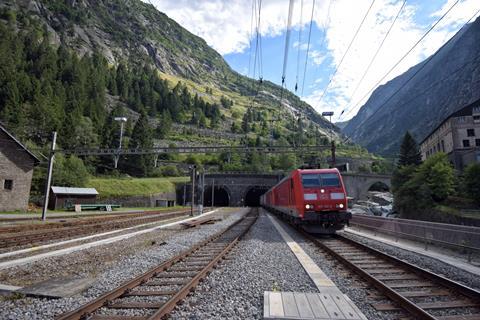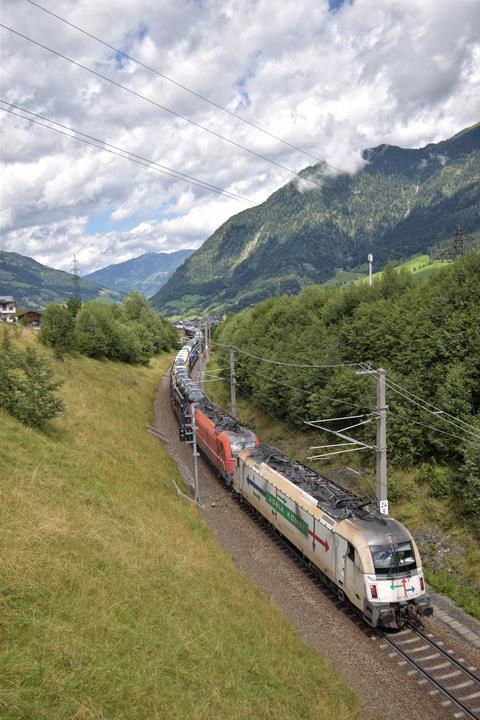SWITZERLAND: The Gotthard Base Tunnel and Brenner Pass trans-Alpine rail routes were closed for much of August. Although both have now at least partially reopened, operators are again being forced to assess how best to manage unexpected disruption. Toma Bačić reports.

The derailment of a freight train and subsequent damage to the world’s longest rail tunnel on August 10 made headlines globally. The resulting partial closure of the Gotthard Base Tunnel exacerbated an already challenging capacity crunch affecting three key north-south trans-Alpine routes this summer.
Although the Alpine region is criss-crossed by a number of double-track electrified main lines, re-routing traffic when one or more is closed is far from simple. This has brought back memories of the problems encountered by rail freight operators when the Rhein Valley main line was closed in 2017 by a tunnel collapse at Rastatt south of Karlsruhe.
Blockade on the Brenner
The derailment in the Gotthard Base Tunnel occurred in the early stages of a planned closure of one of the other key strategic north-south rail freight arteries, the Brenner route linking Rosenheim in Germany and Innsbruck in Austria with Brennero and Verona in northern Italy.

The Brenner Main Line was closed to all rail traffic between August 6-23 for planned maintenance work, which is difficult to undertake for the rest of the year because of the lack of access roads in the high mountains. During these two and a half weeks, Austrian infrastructure manager ÖBB-Infra spent €15m on renewing 11 sets of points, 5 km of plain line, of which 2 km is in tunnel, and installing 4 000 new sleepers and 5 000 tonnes of fresh ballast. The platforms at Steinach am Brenner and St Jodok am Brenner stations were also refurbished.
While passenger traffic was partially replaced by buses, freight services were a much bigger challenge. Most international flows had to be rerouted over the Tauern Pass route which links Villach in Austria with Slovenia and with Tarvisio Boscoverde and Udine in Italy.
While the 328 km Brenner route is double-tracked and electrified throughout, the alternative route through Tarvisio is longer — the distance from Rosenheim to Udine is 398 km — and the ascent on the Austrian side of the border from Schwarzach-St Veit to Böckstein is partly single track. While steep gradients on both the Brenner and Tauern routes necessitate the use of banking locos, the Italian side of the Brenner corridor has benefitted from the construction of several cut-offs and sections of new tunnel to allow faster speeds. These works in turn are part of the preparations for opening of the 64 km Brenner Base Tunnel, now envisaged in the early years of the next decade.
Gotthard diversions
The Gotthard corridor lies some 215 km west of the Brenner, and freight operators have benefitted since June 2016 from the option of using the 57 km base tunnel, rather than the sinuous mountain route opened in 1882.
The Swiss authorities wisely retained the legacy route when the base tunnel opened, not least because of its important role carrying regional passenger services calling at towns bypassed by the new tunnel. However, the legacy route is characterised by long climbs on both sides of the pass, with gradients up to 2·7%, compared to 0·7% for the low-level corridor.
All traffic in the Gotthard Base Tunnel was halted just after 12.45 on August 10, because of a freight train derailment near the Fadio crossover cavern. The investigation undertaken by SBB suggested 16 of 32 wagons on the affected train derailed, damaging the gates which protect the crossover tracks between the two main running bores to manage air circulation and prevent smoke drift in the event of a fire. One set of doors has been so badly damaged that it will have to be fully replaced, which will be a complex process since the doors were of a bespoke design for this tunnel.
The train involved in the accident was a northbound intermodal running from Chiasso Smistamento to Mannheim, hauled by two DB Cargo Class 185 electric locomotives. In Switzerland, SBB Cargo is responsible for operating the train and also provides the driver. According to the Swiss national safety authority Schweizerische Sicherheitsuntersuchungsstelle, fragments of a wagon wheel were found a few kilometres before the accident site, and a broken wheel is suspected of being the primary cause of the accident.
On August 14, SBB announced that the tunnel closure had caused such disruption that it was running out of locations to stable trains and wagons. Two days later, SBB CEO Vincent Ducrot issued a statement outlining the damage to the tunnel and explaining that it could be many months before it fully reopens.

With the base tunnel closed, freight services were rerouted over the summit route, with full access being granted overnight between 23.00 and 05.00. The rest of the time, one path per hour in each direction was allocated to freight services to ensure the route can also handle diverted inter-city and international passenger trains.
Implementing the diversions over the old route threw up a number of specific challenges, not least because double-deck passenger trains cannot be accommodated, and the extended journey times must be factored into the structure of the national Taktfahrplan regular-interval timetable for all public transport services.
Limited service resumes
In its August 16 statement, the national railway said it was working to permit a limited service to resume in the short term using the undamaged eastern bore, and on August 22 this running line reopened for traffic. Almost 100 freight trains per day can now pass through the base tunnel using what is effectively single line working, with ‘flights’ of four trains following each other before the direction of operation is flipped to allow four trains to run through the other way.
However, diversion of about 30 freight trains per day in each direction is nevertheless expected to continue until at least early 2024. Most of those using the original Gotthard pass will be SBB Cargo’s domestic services, as the summit route is not able to handle the 4 m high containers and swap bodies used on many trans-Alpine intermodal flows since completion of the Ceneri Base Tunnel in September 2020.
Operators adapt
For the transit freight operators, there is a further option of using the westerly trans-Alpine corridor through Simplon and the Lötschberg corridor, which, like the Gotthard, has both a summit tunnel route and a base tunnel which opened in 2007. A spokesperson for BLS told Railway Gazette that the company was ‘able to handle additional paths for the freight trains mostly because of the ferragosto public holidays in Italy in August. Currently, about 20 freight trains per day are re-routed from Gotthard through the Lötschberg route’. However, this option is also constrained by engineering works in the older Lötschberg summit tunnel and between Domodossola and Milano until September 10.

Intermodal company Hupac also reported in late August that it was using a combination of the single Gotthard Base Tunnel bore, the summit route and the Lötschberg corridor to get around the capacity constraints. ‘The challenges we are expecting in next weeks and months relate to the development of internationally adapted timetables taking into account the new operational situation in Switzerland’, it added in a statement. It also raised concerns about the amount of stabling facilities either side of the Gotthard tunnels, and called for ‘better co-ordination between railway undertakings’.
FS Group subsidiary TX Logistik has also expressed concerns about stabling facilities on the Gotthard corridor, describing them as ‘exhausted’ at present. Nevertheless, it insisted it was maintaining the majority of its services by using all of the various diversionary routes available, including running more trains over the Brenner Pass since its reopening to traffic on August 24.
However, the operator acknowledged that not all of its key destinations can be easily reached via these alternatives; the Brenner and Tauern passes are ‘not an option’ for services running to or from terminals around Milano, the operator told Railway Gazette on August 29.

















